In This Article
- Overview of Types & Flap Classifications
- How to Describe a Flap - Mnemonic
- Vascular Flap Classification
- Tissue Composition Classification
- Flap Movement Classification
- Secondary Features of Flaps
- References
Types of Flap Classifications
A flap is any tissue with an intrinsic blood supply that is transferred from a donor site to a recipient site.
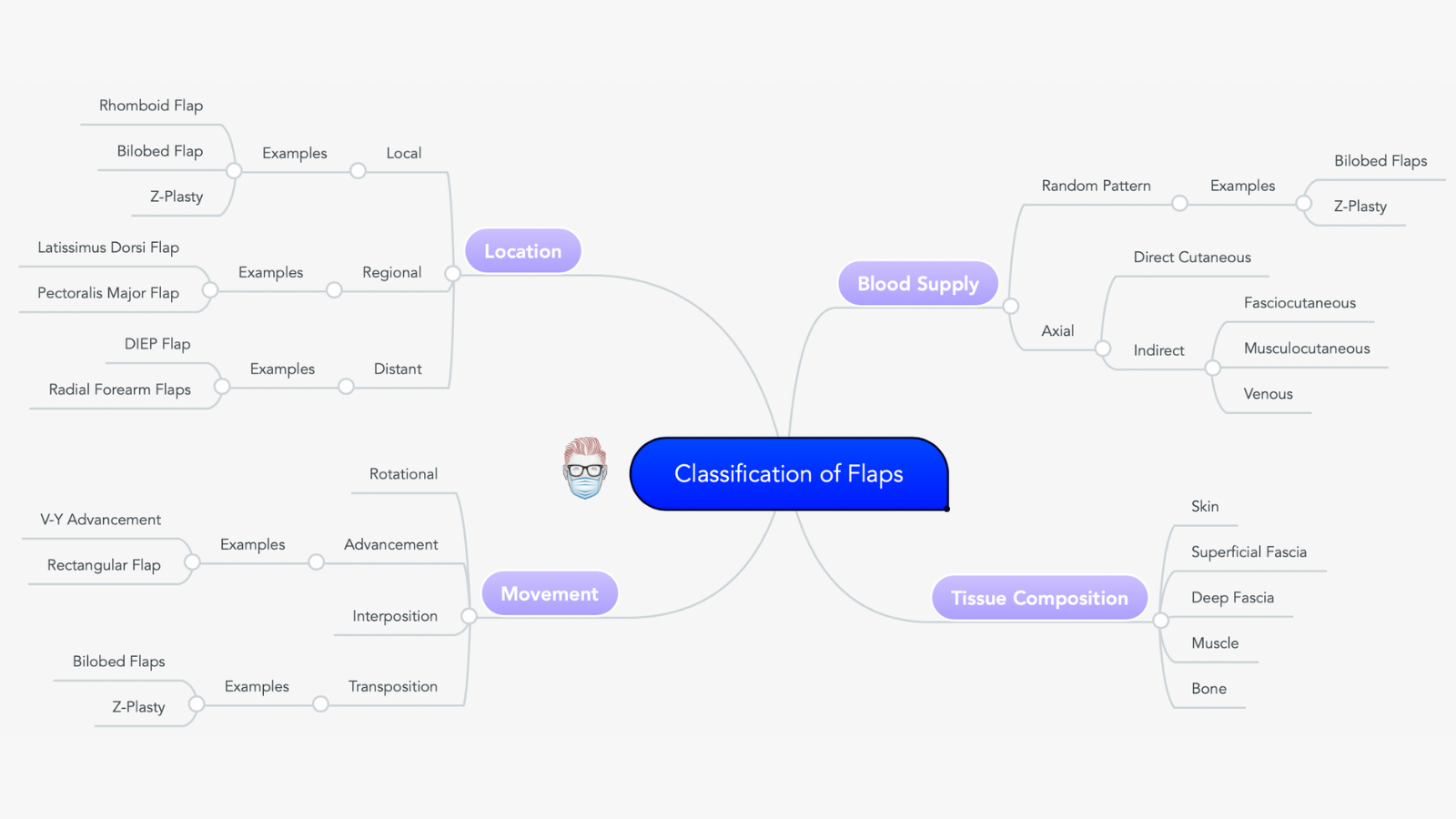
There are several flap classification systems that can each be used to describe the "flap-type" - blood supply, tissue composition, movement, and location. This means flaps can have multiple overlapping classifications, which is often a source of confusion - as illustrated below.
How to Describe a Flap
thePlasticsFella has created the "FLAPS MOVE" mnemonic to describe and classify a type of flap: form/composition, location, attachments, perfusion, special features, and movement of the flap. This memory hook is illustrated below in the diagram.
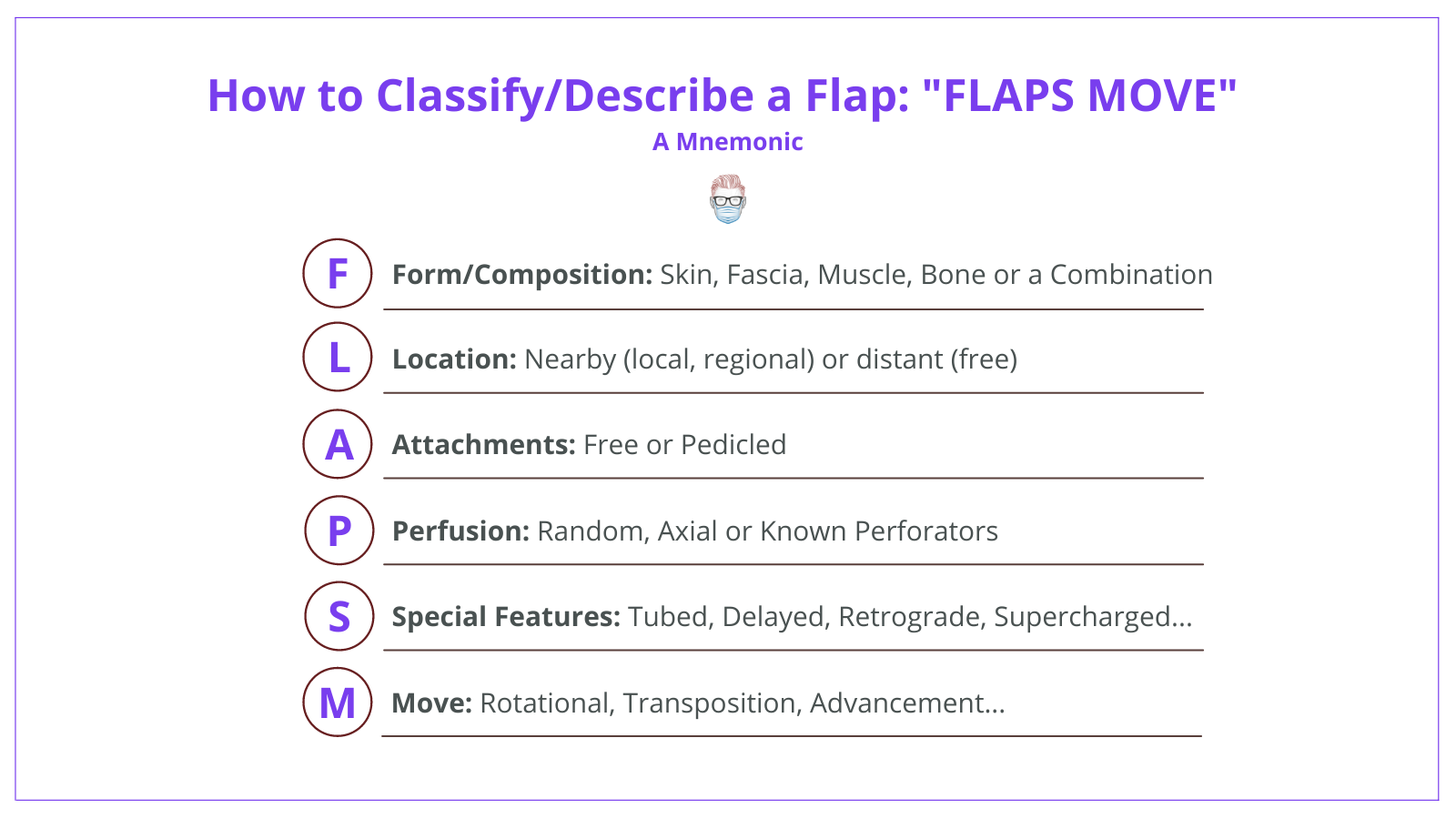
Each descriptive term can be individually applied to describing a type of flap. It can also be used in conjunction with other terms. For example, a rhomboid flap is a random pattern, axial, local transposition skin flap.
Vascular Flap Classification
The circulation to the flap is a key component to understand and describe the type of flap. A broad overview of vascular classification is illustrated below. This is based on the work by McGregor and Morgan8 and the angiosome concept by Taylor.
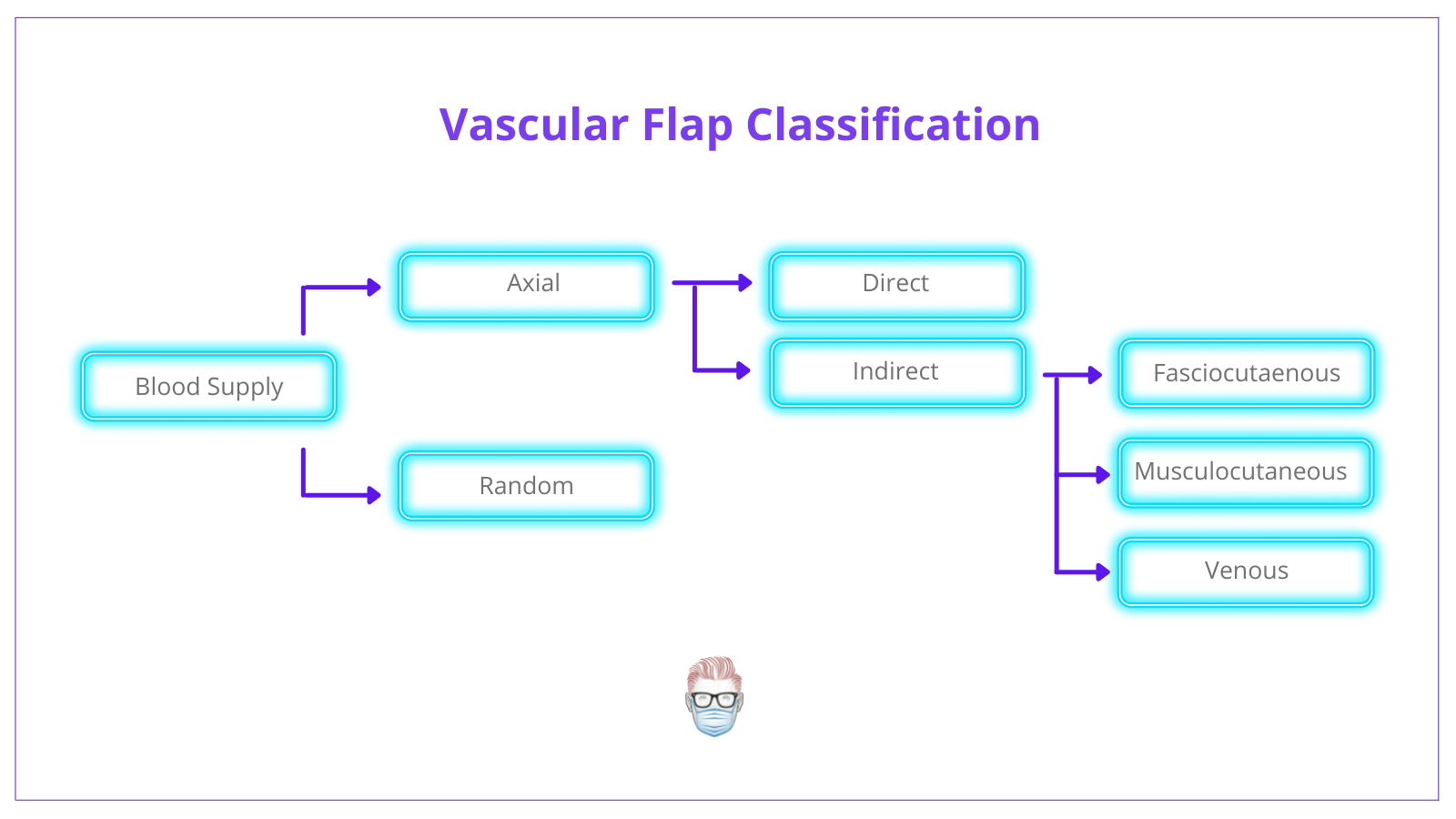
Random Flaps
Random flaps are "random" because they are not based on any specific vessel.
Key points:
- No specific vascular supply but instead uses subdermal plexuss3
- Limited to length-to-width ratios. Actual ratios do vary based on the vascularity of the area. For example, lower limbs have a 1:1 ratio and faces can have 6:1.
Examples: Rhomboid Flap, Bilobed Flap, Z-Plasty
Axial Flaps
Axial Flaps have a single direct cutaneous artery in the longitudinal axis of the flap.
Key points:
- A blood supply in the long axis of the flap
- Named according to the pathway the vessel takes.
- These flaps can be direct or indirect - which is in reference to their perforators4,5,6.
- Their success rate can be increased with the delay phenomenon.
Direct Axial Flaps:
Direct axial flaps are based on the named artery in subcutaneous tissue. The perforators pierce the deep fascia without traversing any deeper structures.
For example:
- Groin flap is based on superficial circumflex iliac vessels.
Indirect Axial Flaps
Indirect axial flaps are based on perforators that pass through deeper tissues, usually in muscle or septum, before entering the fascia.
For Example:
- Fasciocutaneous: based on fascial vessels and classified by Cormack & Lamberty.
- Musculocutaneous: based on perforators travelling through muscle and classified by Mathes and Nahai.
- Venous: less commonly used and classified by Thatte and Thatte.
- Neurocutaneous: based on perforating arteries accompanying cutaneous nerves.
Tissue Composition Classification
Flaps are commonly described in relation to their tissue composition. The type of flap can be composed of skin, fascia, muscle, bone, nerve, cartilage, or a combination.
A broad overview of tissue composition is illustrated in the image below.
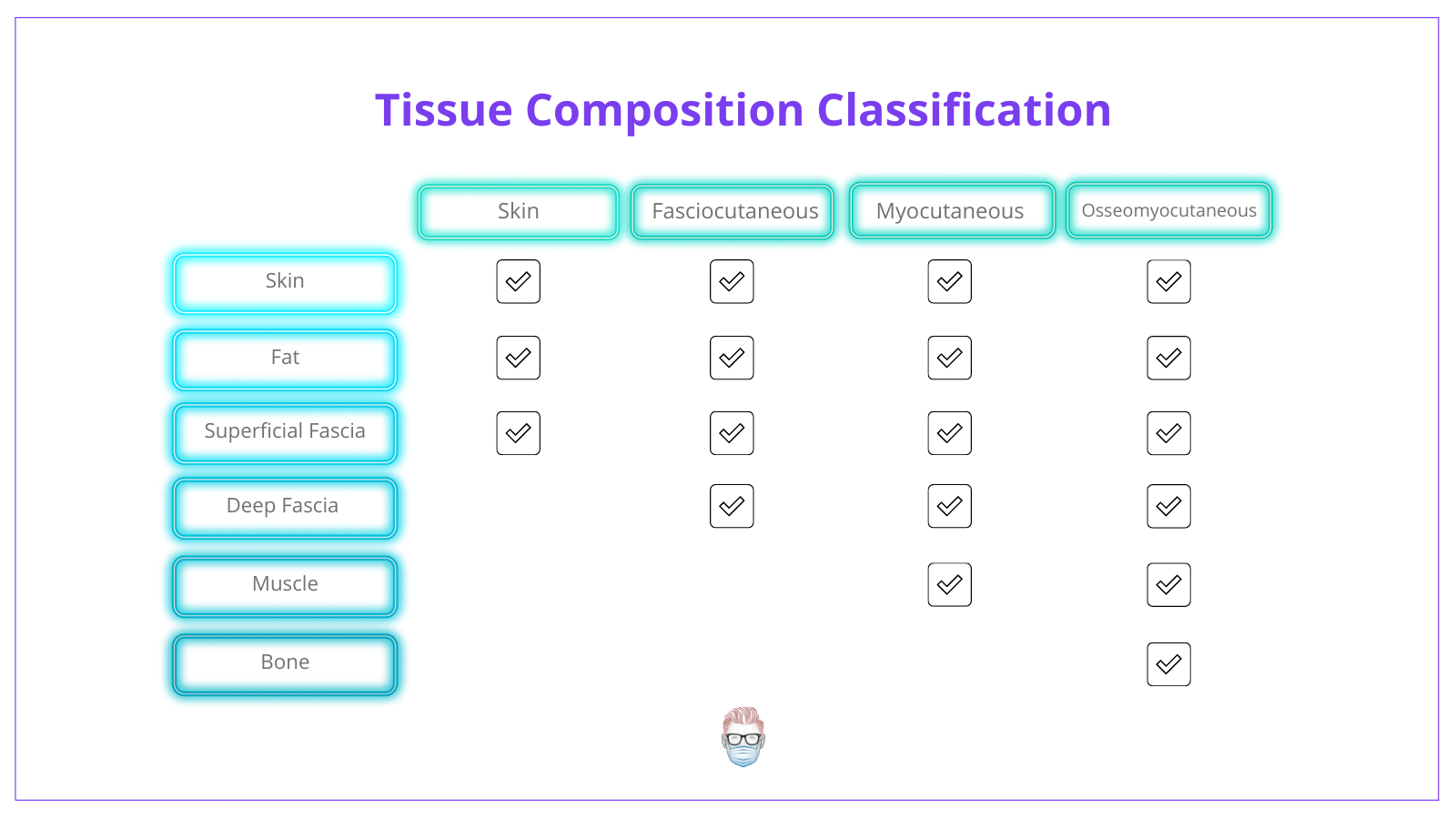
Commonly used flaps are listed below:
- Skin Flap: includes skin and superficial fascia.
- Fasciocutaneous Flap: includes skin and investing layer of deep fascia.
- Fascial Flap: includes the deep fascia only.
- Muscle Flap: include muscle only.
- Myocutaneous Flap: includes muscle and skin.
- Osteomyocutaneous Flap: includes muscle, bone, and skin.
- Bone Flaps: include vascularized bone.
- Visceral Flaps: organs can be transferred based on their pedicles or arcades.
- Innervated Flaps: functional or sensory flaps that incorporate a motor or sensory nerve.
Flap Movement Classification
The method of movement is a common way for a flap to be described or classified. It primarily relates to local flaps. The way the flap is transferred into the defect can be classified as Advancement, Rotation, Transposition, and Interpolation - as illustrated below.
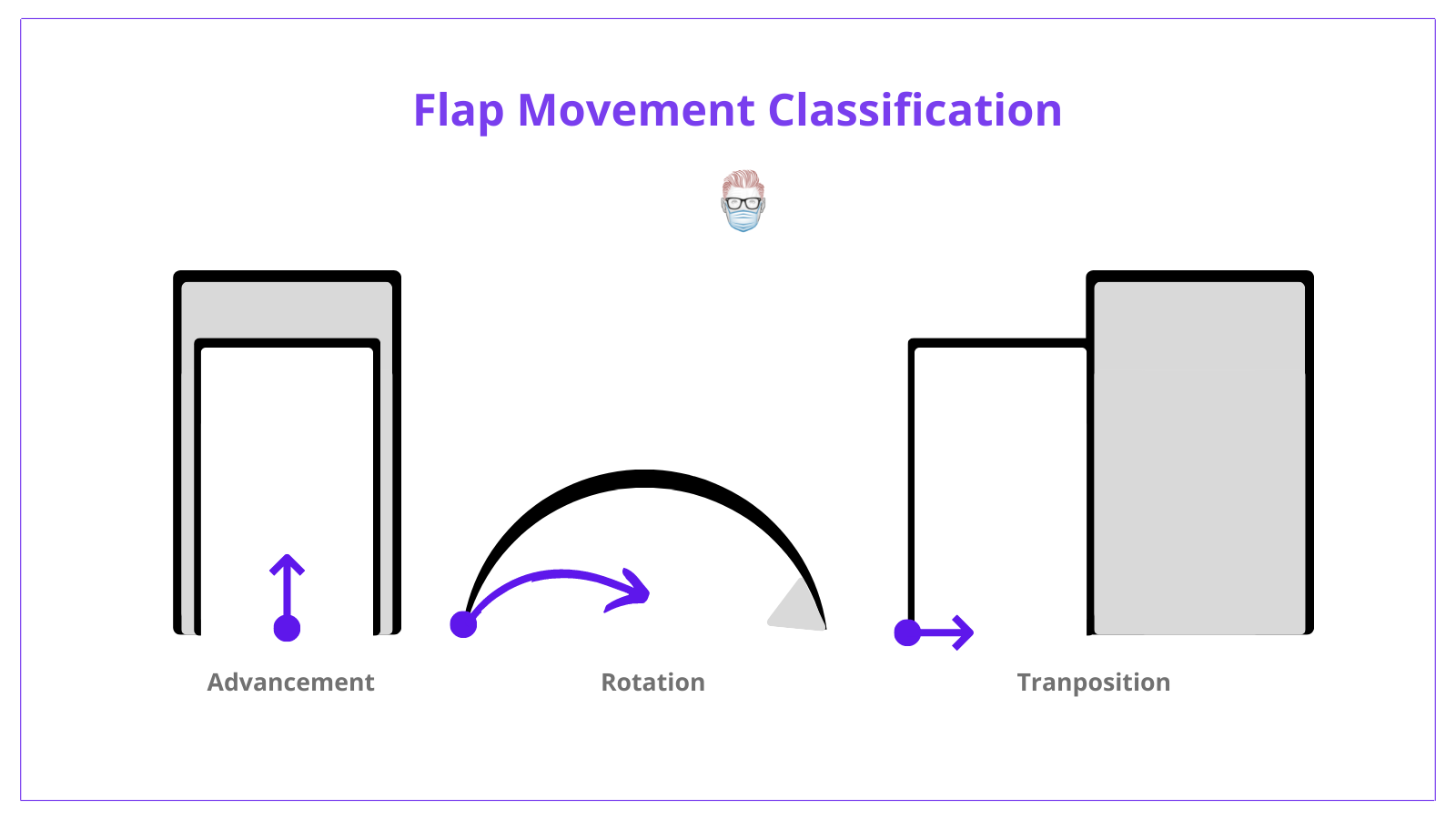
Advancement Flaps
- Unidirectional longitudinal/straight-line movement of tissue.
- Examples: V-Y Advancement, Rectangular Advancement
- Ca require excision of Burow's triangles at flap's base.
- Rotational movement of tissue around a pivot point
- It leaves a donor site defect, which can be closed with the flap.
- To improve the degree of rotation, a back-cut can be made.
Transposition Flap
- Lateral movement of tissue around a pivot point to an adjacent defect.
- It leaves a donor site defect that requires another form of closure.
- Examples: Bilobed Flap, Z-Plasty, Rhomboid Flap.
Interpolation
- Rotate on a pivot point into a near (but not adjacent) donor site.
- The flap travels under or over an intervening bridge of tissue.
- Example: paramedian forehead flap.
Flap Movement Classification
Flaps are often described in relation to their location. 3 commonly used terms to describe the type of flap are local, regional, and distant.
- Local: flap is next to the defect.
- Regional: flap is in the same region as the defect.
- Distant: flap is far away from the defect. These can be pedicled or free flaps.
Secondary Characteristics of Flaps
In an attempt to simplify flap description, Cormack and Lamberty have described the "6 C's of Flaps"1. This provides a broad overview of the different types of flaps. Whilst this table has been referenced already in this article, the secondary characteristics provide further insight into flap classification.
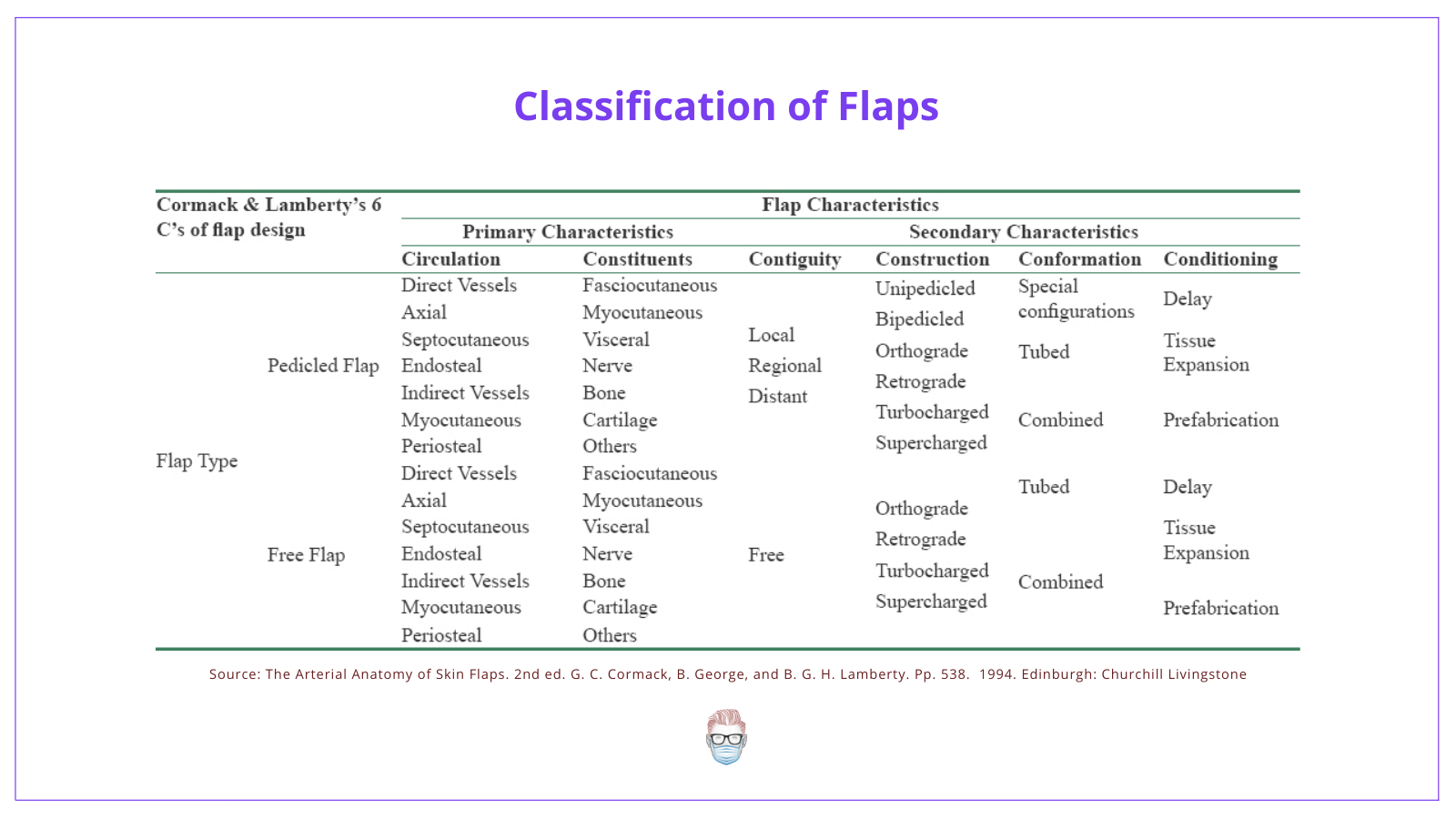
This degree of flap classification is academic. In clinical practice, it would be incredibly difficult to remember all of these areas.
References
Primary Contributor: Manal Nasir, Karachi, Pakistan. Final year MBBS
- Cormack GC, Lamberty BGH. Introduction. In: The Arterial Anatomy of Skin Flaps. Edinburgh: Churchill Livingstone; 1986:1.
- Keil G. [The history of plastic surgery (author's transl)]. Laryngol Rhinol Otol (Stuttg). 1978;57(7):581-91.
- Richards, A. and Dafydd, H., 2015. Key notes on plastic surgery. 2nd ed.
- Cormack GC, Lamberty BG. A classification of fascio-cutaneous flaps according to their patterns of vascularisation. Br J Plast Surg. 1984 Jan;37(1):80-7. doi: 10.1016/0007-1226(84)90049-3. PMID: 6692066.
- Mathes SJ, Nahai F. Reconstructive Surgery: Principles, Anatomy, and Technique. New York: Churchill Livingstone; 1997.
- Mathes SJ, Nahai F. Classification of the vascular anatomy of muscles: experimental and clinical correlation. Plast Reconstr Surg. 1981 Feb. 67(2):177-87.
- Thatte MR, Thatte RL. Venous flaps. Plast Reconstr Surg. 1993 Apr;91(4):747-51. doi: 10.1097/00006534-199304000-00033. PMID: 8446733.
- McGregor IA, Morgan G. Axial and random pattern flaps. Br J Plast Surg. 1973 Jul;26(3):202-13. doi: 10.1016/0007-1226(73)90003-9. PMID: 4580012.


